This guide will aid the player in getting started with GregTech Community Edition.
Before beginning[]
It will be helpful to install the following additional mods:
- Just Enough Items, to help look through the many complex recipe chains in this mod.
- A minimap mod such as JourneyMap, to save the location of important places.
- Mods for item logistics such as Applied Energistics 2 or Ender IO, as GregTech Community Edition currently does not have a way of dealing with items.
- A mod such as WAILA.
Additionally, be sure to allocate sufficient RAM to your Minecraft instance. If you are running GTCE on its own with minimal other mods, you may require 3 - 4 GB of RAM dedicated to your Minecraft instance. For a larger modpack, you may need up to 8 - 10 GB, depending on how demanding it is.
Starting out[]
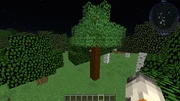
A Rubber Tree
Changes to the world[]
When you begin a new GregTech world, you may notice two different additions to the world: Rubber Trees and Surface Rocks.
Rubber Trees when broken down yield Rubber Wood and Rubber. Rubber is useful for making insulated Cables. They are distinguishable from other trees by their tall height and bright leaf color. Be sure to collect the tree's Saplings, as they are slightly uncommon.
Surface Rocks are small stones containing 1 nugget of their metal. They provide a tiny amount of metal resource, which is a way you can collect small amounts of later-game resources early. Most importantly, they indicate the presence of a large vein of ore underneath them.
In GregTech, ores spawn in extremely large clusters, or veins. Every 3x3 chunk area of the world, or a section, will have one or more ore veins containing 2 - 4 different types of ores. A single ore vein can be 10 - 20 blocks wide, containing 1,000 - 5,000 ore blocks. It is a good practice to save the location of all ore veins you come across, as they are very large and will last you a while.
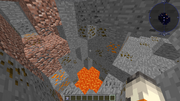
A Chalcopyrite vein. This one contains Iron Ore, Copper Ore and Chalcopyrite Ore (which smelts into Copper).
Each type of ore vein will have a set Y level range at which they can spawn, as well as a group of ores it can contain. For example, the pictured Chalcopyrite vein contains Iron, Copper and Chalcopyrite, which smelts to Copper also. Look through JEI to find the various uses of an ore.
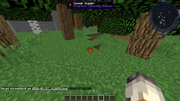
A Copper Surface Rock, indicating the presence of a large Copper vein underneath it.
First steps[]
Once you have a standard survival base, it's time to go searching for important materials. You will need a source of Copper, Tin and Iron to begin. You will also need a significant amount of Clay.
- Tin comes from Cassiterite veins, which spawn close to the surface.
- Copper spawns as Pentlandite higher in the world, and Chalcopyrite deeper down. However, you may wish to save Chalcopyrite, as later you can process it for Platinum Group Sludge, which is an early source of Osmium, Platinum, Iridium and other valuables. It also can come from a number of other sources, such as Chalcocite and Malachite.
- Iron can be found in Magnetite veins along with Vanadium Magnetite and Gold. Limonite veins are slightly denser in iron, and also contain Malachite for Copper.
Make sure to mark off locations of ore veins you find on a map or in a text file somewhere, as you will return to them multiple times. It's advisable to spend a while mining out important veins like these - GregTech is extremely resource-heavy, and you will save time by mining ores in bulk. Area mining tools such as Hammers from Thermal Foundation, or veinmining with Ore Excavation may help with this task.
Should you encounter any other types of veins, feel free to take with you a few blocks from it and be sure to mark it on your map. Later on, you will build ore-processing chains to obtain useful byproducts from all types of ore. Nickel, Redstone, Oil, Diamond, Silver, and Aluminium will all be useful very soon. A Coal vein is also a useful find so you don't have to destroy forests for Charcoal.
When you get home, feel free to simply smelt directly all your smeltable ores - proper ore processing won't be available for a while, and your Copper vein likely still has 2,000+ ore blocks left. Then, take about half of your Iron, convert it into Nuggets and shove all of them into a Furnace for Wrought Iron (you can only do it nugget by nugget). Next, make a Mortar with 5 Stone and 2 valid metal ingots, and a Hammer with 6 valid metal ingots and a Stick. If you have Cobalt, Uranium 238 (it isn't radioactive enough to damage you) or another valid tool material, you can use those as tool material to save on your other metals. Otherwise, you can use Iron or Wrought Iron.
Smash Copper and Tin into Copper Dust and Tin Dust, craft 3 Copper Dust with 1 Tin Dust to create Bronze Dust, and smelt it into Bronze Ingots. You'll need a lot of this, so perhaps create a few stacks. Don't use all your Copper and Tin though, as they are useful for other things. Bronze is the main material for your next step - the Steam Age.
Steam age[]
First machines[]
Before you can progress further, you'll need some tools. Make a File, Saw, Wire Cutter, Knife and Wrench out of suitable materials. You may also wish to craft an Axe, which chops whole trees at once, a Pickaxe, a Sword, and a Butchery Knife, which has Looting III on it.
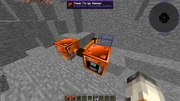
A basic Steam setup to power a Forge Hammer. Excess Steam can be stored in Tanks as a buffer.
Make some Bronze Plates with a Hammer and 2 Bronze Ingots - no bothersome Double Ingots here. Use those Bronze Plates with Bricks and a Furnace to create a Bricked Bronze Hull. Then, create a Small Coal Boiler. Insert lots of water and some Coal, and you'll begin producing Steam! If you have another mod which is able to provide a source of Steam, such as Steam Dynamos with Boiler Conversion from Thermal Expansion, you may use those for powering Steam machines.
If you installed another mod with fluid pipes, you can use those for getting Steam into machines. Otherwise, make some Bronze Pipes to get Steam to your machines. The first machine you should make is a Forge Hammer, which allows you to create 2 plates from 3 ingots, rather than 1 plate from 2 ingots. Then, make a Compressor for Fireclay.
For Steam Machines to operate continuously, their back side should be exposed to air. Additionally, make sure your boilers are filled with water at all times. Should it run out of water, you will have to wait for its heat level to go back down, or it will blow up. Don't touch GTCE Pipes with Steam in them, as they will damage you.
You may also be interested in upgrading your Crafting Table to a Crafting Station. It can store tools in its inventory, pull from adjacent inventories and remember up to 9 recipes. With all the part crafting GTCE brings, this can be a life-saver.
Primitive Blast Furnace[]
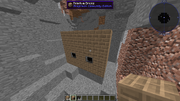
Save on bricks for your second PBF with side sharing.
The next step will require massive amounts of Clay - about 8 stacks of balls minimum. Head over to the nearby river and start digging. Smelt 4 stacks of clay balls into Bricks, macerate the Clay and Bricks with Mortars, and mix them together to form Fireclay Dust. Compress it into balls with your Compressor, smelt them into Fireclay Bricks, and craft them into Primitive Bricks.
Now it is time to build the Primitive Blast Furnace. It's a slow machine, but it will get you Steel, which you will need next. Make a Primitive Blast Furnace block, then follow the instructions on the tooltip to construct the Furnace. Insert Iron and Coal, and it will slowly start to produce Steel. Using Wrought Iron makes it go faster. Avoid building multiblocks across chunk borders - strange behavior can result from it, which can lead to loss of materials.
Steel is an extremely important resource. It is used for a wide range of things, the most current ones being High Pressure Steam machines and LV Machine Hulls. Make sure it is being produced constantly, and consider building multiple PBFs for Steel, because you will never have enough of it. You can save on Primitive Bricks when you share sides with another PBF - this is true for all GTCE multiblocks.
With your Steel cooking away, you're ready for the next stage of GregTech - electricity.
Basic electricity[]
How electricity works[]
GTCE Electricity is significantly more complex than a simple form of energy such as RF, and must be handled with care. If electricity is handled improperly, it could lead to machines exploding, player death, and loss of materials. Always ensure you have correctly configured your electricity network before changing anything.
Electricity in GregTech comes in voltages. Each voltage has a maximum EU per tick (EU/t) it can handle. For example, LV machines can handle recipes up to 32 EU/t. The different tiers of voltage are shown below:
| Name | Voltage (EU/t) |
|---|---|
| Low | 32 |
| Medium | 128 |
| High | 512 |
| Extreme | 2048 |
| Insane | 8192 |
| Ludicrous | 32768 |
| ZPM | 131072 |
| Ultimate | 524288 |
| MAX | 2147483647 |
In addition to volts, the number of connections a wire can conduct electricity to is determined by its Amperage, measured in Amps (A). A machine uses Amps according to how much EU/t it uses, divided by the maximum EU/t of a machine. For example, an LV machine (32 EU/t) doing a 24 EU/t recipe will only use 0.75 A. All generators output 1A.
Electricity is transmitted with Wires and Cables. Each wire has a maximum Voltage, maximum Amperage and loss per block. Maximum Voltage and Amperage should be simple enough. Loss per block is how much EU/t per block is lost when a current passes through the cable. For example, a 32 EU/t current going through a 10-long Tin cable (1 loss per block) will emerge with only 22 EU/t. As such, it is important that you keep your wires as short as possible to reduce cable loss.
Cables and Machines which receive higher than their maximum Voltage and Amperage values will burn or explode. Never connect two different voltages of wire or machine. You can change the voltage of a signal with a Transformer.
Finally, you can store EU and transform between Amps with a Battery Buffer. They only output as many Amps as they have batteries in them. If you have generators in RF, you must convert RF to EU with another mod, such as Universal Cable from Mekanism. The conversion rate is 4 RF to 1 EU.
Overclocking mechanic[]
By default all machines start with overclocking enabled. Base overclocking allows you to divide your recipe time either by 2.7 or 2.0 (division by 2 if EU/t<=16, otherwise by 2.7) by multiplying the energy usage by 4 at the same time.
1-2 EU/t recipes overclock twice at LV (1->4->16 and 2->8->32)
3-8 EU/t recipes overclock once at LV (3->12, 4->16 etc)
9-32 EU/t recipes don't overclock at all at LV
Example;[]
A recipe is 1 EU/t, 20 seconds = 400 ticks
- 1EU/t -> 4EU/t, 200 ticks (LV)
- 4EU/t -> 16EU/t, 100 ticks (LV)
- 16EU/t -> 64EU/t, 37 ticks (MV)
- 64EU/t -> 256EU/t, 13 ticks (HV)
- and so on
Another recipe is 6EU/t, 11 seconds = 220 ticks
- 6EU/t -> 24EU/t, 110 ticks (LV)
- 24EU/t -> 96EU/t, 41 ticks (MV)
- 96EU/t -> 384EU/t, 15 ticks (HV)
LV machines[]
With that out of the way, you can now make some LV Machine Hulls with the Steel you have. However, you'll notice that to craft the machines themselves, you'll need new, more advanced components. Circuits are used in all machines, and some may need components such as Motors, Pistons, etc. At first, they will be hard to craft, but as your infrastructure gets better and you progress through the voltage tiers, you'll notice the material costs will decrease.
You will need Red Alloy for Circuits and Magnetic Iron Rods for Motors. They are made by combining 1 Copper Dust or 1 Iron Rod respectively with 4 Redstone in a crafting table.
You'll need a source of power for your machines, so let's craft that first. If you have RF generators and RF-EU converters to play with, you can use those in place of GT generators. Otherwise, you have a few options for power.
- Pipe Steam from a Boiler or Large Boiler into Steam Turbines - without any LV machinery, this is probably what you'll begin with.
- Extract Methane from food products and burn it in a Gas Turbine.
- Mass-produce Solar Panels - probably best saved for when you can get Circuits cheaper.
Whatever you choose, hook it up to a Cable of appropriate Amperage. Likely this will be Tin, as most other cables will be too lossy. Now, you can put some machines on the cable, and they will be able to produce power. You may consider adding a Battery Buffer with Batteries inside as a power reserve.
The first machine you should make is a Polarizer. It allows you to make make magnetic rods out of metals without using any redstone. Next on your list is a Wiremill which increases your wire yield by 2 and additionally allows you to produce fine wire that can be used in some recipes as a substitute for regular wires.
After you make the Wiremill, consider making 64 additional LV motors. Yes, 64. An important skill for this mod is bulk crafting and processing - motors are used in almost every LV machine, so you may as well make all of them at once, rather than have to do it every time you wish to craft a new machine. You will eventually use all 64, so there's no fear in wasting materials. This carries over to many other components, so don't be afraid to make extras.
Next up on the list is an Assembler. This machine quadruples your Resistor yield, allows you to use liquid Rubber instead of Black Carpet to insulate cables, and unlocks new components for better circuits. Go ahead and bulk-craft Circuits like you did with Motors before, too.
Other machines you can consider making include:
- Bending Machine - makes 1 plate from 1 ingot.
- Lathe - makes 2 rods from 1 ingot.
- Fluid Extractor - get liquid Rubber from resin Rubber or liquid metal/glass out of ingots/glass blocks respectively for use in the Assembler.
- Centrifuge - extracts Methane from ie. food products such as fish, which can be burned for power.
- Alloy Smelter - allows creation of alloys without having to combine dusts.
- Electrolyzer - get Oxygen from various materials, used for the next, quicker, more effective way of producing Steel.
- Electric Furnace - smelts things quicker.
Electric Blast Furnace[]
The electric blast furnace can create a variety of new alloys and metals, and is one of the most used machines in Gregtech. It can be used to create things such as Aluminum, which is required to advance ion the game to Medium Voltage technology.
| |||||||||||||||||||||||||||||||||||||||||||||||||||||||||||||||||||||||||||||||||||||||||||||||||||||||||||||||
